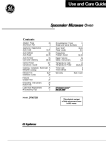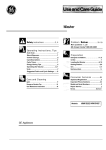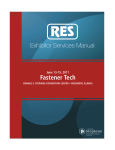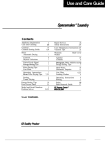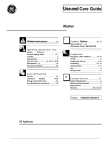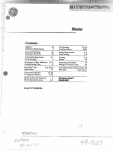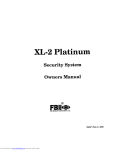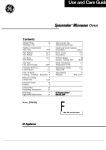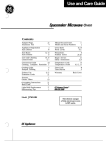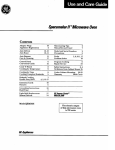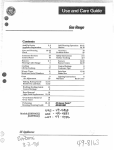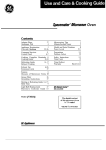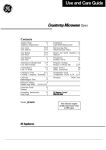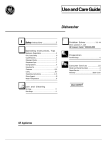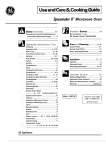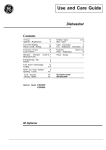Download GE JVM172J User's Manual
Transcript
Spacemaker”Micmave Oven Contents Adapter Plugs Aluminum Foil 29 4 Microwaving Tips Minute/Second Timer 3 9 Appliance Registration Auto Cook 2 19-24 Model and Serial Numbers Oven Shelf 5, 26,2; Auto Defrost Auto Reheat 16, 17 14, 15 Power Levels Precautions Auto Roast Auto Start 12, 13 11 Problem Solver Recipes, Cooking Tips Auto Simmer Care and Cleaning 13 28,29 Safety Instructions Temperature Cook 2-5 11 Consumer Services Control Panel 31 6.7 Temperature Probe Time Cook 11-13 10 10 Cook ‘N Watch Cooking Complete Reminder 8 Delayed Cooking Exhaust Fan 9 6,29 Extension Cords Features 29 8 Grease Filter Grounding Instructions 29 29 Hold Time Light Bulb Replacement 9 28 Mode1JW172J Time Defrost Warranty 9-12 2-5 21.;: 18 Back Cover GEAmwer CetieP 8~.B6.2W The el~tric output of this microwave oven is 750 watk~ *IEC-~5 Test Procedure r GEAppRmces Help us help you... Before using your oven, read this book carefully. It is intended to help you operate and maintain your new microwave oven properly. Keep it handy for answers to your questions. If you don’t understand something or need more help, write (include your phone number): Consumer Affairs GE Appliances Appliance Park Louisville, KY40225 Write down the model and serial numbers. You’ll find them on a label inside the oven. These numbers are also on the Consumer Product Ownership Registration Card that came with your microwave oven. Before sending in this card, please write these numbers here: Model Number Serial Number Use these numbers in any correspondence or service calls concerning your microwave oven. Be sure your microwave oven is registered. It is important that we know the location of your microwave oven should a need occur for adjustments. Your supplier is responsible for registering you as the owner. Please check with your supplier to be sure he has done so; also send in your Consumer Product Ownership Registration Card. If you move, or if you are not the original purchaser, please write to us, stating model and serial numbers. This appliance must be registered. Please be certain that it is. Write to: GE Appliances Range Product Service Appliance Park Louisville, KY40225 If you received a damaged oven . . . Immediately contact the dealer (or builder) that sold you the oven. NEXT, if you are still not pleased, write all the details-including your phone number—to: Manager, Consumer Relations GE Appliances Appliance Park Louisville, Kentucky 40225 FINALLY, if your problem is still not resolved, write: Major Appliance Consumer Action Panel 20 North Wacker Drive Chicago, Illinois 60606 Save time and money. Before you request service... check the Problem Solver on page 30. It lists causes of minor operating problems that you can correct yourself. All these things are normal with your microwave oven. ● Steam or vapor escaping from around the door. ● Light reflection around door or outer case. Dimming oven light and change in blower sound may occur while operating at power levels other than high. ● ● Dull thumping sound while oven is operating. ● Some TV-Radio interference might be noticed while using your microwave oven. It’s similar to the interference caused by other small appliances and does not indicate a problem with your oven. If you need service... To obtain service, see the Consumer Services page in the back of this book. We’re proud of our service and want you to be pleased. If for some reason you are not happy with the service you receive, here are three steps to follow for further help. FIRST, contact the people who serviced your appliance. Explain why you are not pleased. In most cases, this will solve the problem. 2 PMCAUTIONS TO AVOD POSS~LE EXPOSURE TO EXCESSIVE ~CROWAVE ENERGY (a) Do Not Attempt to operate this oven with the door open since open-door operation can result in harmful exposure to microwave energy. It is important not to defeat or tamper with the safety interlocks. ~) Do Not Place any object between the oven front face and the door or allow soil or cleaner residue to accumulate on sealing surfaces. (c) Do Not Operate the oven if it is damaged. It is particularly important that the oven door close properly and that there is no damage to the: (1) door (bent) (2) hinges and latches (broken or 100send) (3) door seals and sealing surfaces. (d) The Oven Should Not be adjusted or repaired by anyone except properly qualified service personnel. ~ORTNT S~ETY ~STRUCTIONS — Read all imtructions before mi~ thk appliance. Microwaving Tips ● Make sure all cookware used in your microwave oven is suitable for microwaving. Most glass casseroles, cooking dishes, measuring cups, custard cups, pottery or china dinnerware which does not have metallic trim or glaze with a metallic sheen can be used. Some cookware is labeled “suitable for microwaving.” If you are not sure if a dish is microwave-safe, use this test: Place in the oven both the dish you are testing and a glass measuring cup filled with one cup water—set the measuring cup either in or next to the dish. Microwave 1 minute at high. If the dish heats, it should not be used for microwaving. If the dish remains cool and only the water in the cup heats, then the dish is microwave-safe. ● Rper towels, wax paper and plastic wrap can be used to cover dishes in order to retain moisture and prevent spattering. Be sure to vent plastic wrap so steam can escape. ● Some microwaved foods require stirring, rotating or rearranging. Check the cookbook. ● Steam builds up pressure in foods which are tightly covered by a skin or membrane. Pierce potatoes, egg yolks and chicken livers to prevent bursting. When using electrical appliances, basic safety precautions should be followed, including the following: WARNING–TO r~uce the risk of burns, electric shock, fire, injury to persons or exposure to excessive microwave energy: ● Use this apptiance only for is intended use as described in this manual. ● Read and follow the specific “PRECAUTIONS TO AVOID POSSBLE EXPOSUM ~ EXCESSIVE MICROWAVE ENERGY” on page 2. ● This appliance must be grounded. Connect only to properly grounded outlet, See “GROUNDWG~STRU~ONS” on page 29. . This microwave oven is specifically designed to heat or cook food, and is not intended for laboratory or industrid use. ● For best operation, plug this appliance into ik own electrical outlet, to prevent flickering of lighb, blowing of fuse or tripping of circuit breaker. o Instil or locate this appliance only in accordance with the provided kWation Mtruetions. ● Do not cover or bl~k any openings on the appliance. ● Do not use outdoors. ● Do not immerse power cord or plug in water. ● &p power cord away from heated surfaces. ● Do not let power cord hang over edge of tible or counter. ● DO not operate this apptiance if it has a damaged power cord or plug, if it is not working properly, or if it has been damaged or dropped, ~ ● See door surface cleaning instructions on page 28. ● This appliance should be serviced ody by qutified service personnel. Contact nearest authorized service facility for examination, repair or adjustment. Q As with any appliance, close supervision is necessary when used by children. ● To reduce the risk of fire in the oven cavity: –Donot overcook food. Carefully attend appliance if paper, plastic, or other wmbustible materials are placed inside the oven to ticflitate cooking. –Remove wire twist-ti= from paper or plastic bags before placing bags in oven. —Do not use your microwave oven to dry newspapers. –Do not use recycled paper products. Recycled paper towels, napkins and wax paper can contain metal flecks which may cause arcing or ignite. Paper products containing nylon or nylon filaments should be avoided, as they may also ignite. –Do not pop popcorn in your microwave oven udess in a special microwave popcorn accessory or udess you use popcorn labeled for use in microwave ovens. –Do not operate the oven while empty to avoid damage to the oven and the danger of fire. If by accident the oven should run empty a minute or two, no harm is done. However, try to avoid operating the oven empty at all times–it saves energy and prolongs the life of the oven. –Do not overcook potatoes. They could dehydrate and catch fire, causing damage to your oven. IMPORTANT SAFETY ~STRUCTIONS c Ifmat~rials inside oven should ignite, keep oven door closed, turn oven off, and disconnect power cord, or shut off power at the tise or circuit breaker panel. ● Some products such as whole eggs and sealed containers-for example, closed jars-wti explode and should not be heated in this microwave oven. Such use of the microwave oven codd result in injury. c Avoid heating baby food in glass jars, even without their lids; especially meat and egg mixtures. . Don$t defrost frown beverages in narrow necked bottles (especially carbonated beverages), Even if the container is opened, pressure can buildup. This can cause the container to burst, possibly resulting in injury. ● Use meti ody as directed in this book and the cookbook provided. TV dinners maybe microwaved in foil trays less than 3/4” high; remove top foil cover and return tray to box. When using meti in the microwave oven, keep mehl (other than metal shel~ at least 1 inch away from sides of oven. ● Cookware may become hot because of heat transtirred from the heated food. Pot holders may be needed to handle the cookware. Sometimes, the oven floor can become too hot to touch. Be ● careful touching the floor during and after cooking. ● Foods cooked in liquids (such as pasta) may tend to boil over more rapidy than foods containing less moisture. Should this occur, refer to page 28 tir instructions on how to clean the inside of the oven. ● Thermometer—Do not use a thermometer in food you are microwaving udess the thermometer is designed or recommended for use in the microwave oven. . Remove the temperature P~~ from the oven when not using it to cook with. If you leave the probe inside the oven without inserting it in food or liquid, and turn on microwave energy, it can create electrical arcing in the oven and damage oven walls. ● Plastic cookware—Plastic cookware designed for microwave cooking is very useful, but should be used carefilly. Even micmvesafe plastic may not be as tolerant of overcooking conditions as are glass or ceramic materials and may soften or char if subjected to shofi periods of overcooking. In longer exposures to overcooking, the food and cookware could ignite. For these reasons: 1) Use microwave-safe plastics only and use them in strict compliance with the cookware manufacturer’s recommendations. 2) Do not subject empty cookware to microwaving. 3) Do not permit children to use plastic cookware without complete supervision. ● men cooking pork, follow the directions enctly and always cook the meat to an internal temperature of at least 170°F. This assures that, in the remote possibility that trichina may be present in the meat, it will be Med and meat will be safe to eat. ● Do not boti eggs in a microwave oven. Pressure will build up inside egg yolk and will cause it to burst, possibly resulting in injury. 4 (continued) Foods with unbroken outer “skin” such as potatoes, sausages, tomatoes, apples, chicken livers and other giblets, and egg yolks (see previous caution) should be pierced to allow steam to escape during cooking. . Not all plastic wrap is suitable for use in microwave ovens. Check the package for proper use. . ~~Boi]able” cooking pouches and tightly closed plastic bags should be slit, pierced or vented as directed by package. If they are not, plastic could burst during or immediately after cooking, possibly resulting in injury. Also, plastic storage containers should be at Imt partidy uncoveti because they form a tight seal. When cooking with containers tightly covered with plastic wrap, remove covering carefully and direct steam away from hands and face. Q Spontaneous boiling—Under certain special circumstances, liquids may start to boil during or shortly after removal from the microwave oven, To prevent burns from splashing liquid, stir the liquid briefly before removing the container from the microwave oven. ● - SAVE THESE INSTRUCTIONS THEEXHAUSTHOOD ● Have it installed and properly grounded by a qtiled instier. See the special initiation boo~et packed with the microwave oven. c The exhaust fan in the oven ~ operate automati~y under certain wnditions (see Automatic Fan Feature, page 6). While the fan is operating, caution is required to prevent the starting and spreading of accidental cooking fires while the exhaust fan is in use. For this reason: –Never leave surface units unattended at high heat settings. Bodovercausessmobg and greasy spillovers that may ignite and spread if etiaust fan is operating. To minimize automatic fan operation, use adequate sized cookware and use high htit ordy when necessary. —In the event of a grease fire, smother flaming pan on surface unit by covering pan completely with well-fitting lid, cookie sheet or flat tray. USE OF THE OWN SHELF ACC~SORY ● Remove the shelf from oven when not in use. Q Do not store or cook with shelf on floor of oven. Product damage may result. c Use potholders to handle shelf and cookware. They may be hot. ● Do not use microwave browning dish on shelf; the shelf could overheat. Do not use shelf with Automatic Cooking feature. –Never flame foods under the oven with the exhaust fan operating because it may spread the flames. –Keep hood and grease filters clmn, according to instructions on page 29, to mainmin good venting and avoid grease fires. 5 Optional Accessory Available at extra cost from your GE supplier. J~lA Charcoal Filter Kit for non-vented installation. r This microwave oven is UL listed for installation over electric and gas ranges. Your Touch Control Wnel The Touch Control Panel allows you to set the oven controls electronically with the touch of a finger. It’s designed to be easy to use and understand. 9. EXHAUST FAN. Press HI, LO or OFF for the different fan speeds. 10. TEMP COOK/HOLD. Use the temperature probe to cook by using a preset temperature. Once food reaches preset temperature, oven switches to HOLD setting and maintains that temperature until you touch the CLEAR/OFF pad. (See page 11.) When You Plug in the Oven The display panel displays five 8’s, 18 POWER and all of the oven functions. After 15 seconds, all lights disappear and “RESET” appears in the upper portion. Touch the CLEAR/OFF pad, set the CLOCK and oven is ready for use. If power is disrupted at any time, the above sequence recurs, and you must reset CLOCK after touching the CLEAR/OFF pad. U. COOK ‘N WATCH. Use this pad for short-term cooking which automatically turns oven off after 3 minutes. (See page 10.) “Error” Appears on the Display: ~. MIN/SEC TIMER. This feature uses no microwave energy. It functions as either a kitchen timer, as a holding period after defrost or as a delay timer before time or temperature cooking. (See page 9.) ● During Auto Cook or Auto Reheat program, the door was opened before steam could be detected. U. MIN. Use with number pads to enter whole minutes. For example, for 4 minutes touch 4 and MIN. “PRObE” Appears on the Display 14. NUMBER PADS. Touch these pads to enter cooking time, defrosting time, time of day, temperature, power level, Auto Codes or food weights for Auto Defrost. ● Probe has been forgotten when Auto Roast or Temp Cook/Hold function is being used. 15. POWER LEVEL. Touch this pad before entering another power level number if you want to change from automatic power level 10 (High) for cooking or power level 3 (Low) for defrosting. c Probe is not securely seated in oven wall receptacle. 1. DISPLAY. Displays time of day, time or temperature during cooking functions, power level being used, cooking mode and instructions. 16. START. After all selections are made, touch this pad to start the oven. 2. TIME COOK I & II. Microwave for a preset amount of time using automatic power level 10. (If desired, you may change power level after entering cooking time. See page 10.) 17. AUTO ROAST. Insert probe, touch this pad and then number pad for desired code number to slow-cook or temperature cook meat with automatic preset program. (See pages 12 and 13.) 3. TIME DEFROST. Gentle thawing at automatic power level 3 (Low). (If desired, you may change power level after entering defrosting time. See page 18. ) 18. AUTO DEFROST. Touch this pad and food weight. The oven automatically sets power levels and defrosting time. (See page 16.) 4. CLOCK. Touch this pad to enter time of day or check time of day while microwaving. To set clock, first touch CLOCK pad and then enter time of day. For example, if time is 1:30, touch number pads 1, 3 and O and “1:30” will appear in display. Then touch START pad. To reset or change time, simply repeat above process. U. LIGHT. Touch desired pad to illuminate counter or to turn on night light. AU~MATIC FAN FEAT~ Cooking appliances installed under the oven may, under some heavy usage conditions, cause temperatures high enough to overheat some internal parts of the microwave oven. To prevent overheating from taking place, the exhaust fan is designed to automatically turn on at a low speed if excessive temperatures occur. Should this happen, the fan can not be manually turned off, but it will automatically turn off when the internal parts have cooled. The fan may stay on up to approximately 30 minutes after the range and microwave oven controls have been turned off. 5. AUTO START. Allows you to program your oven to begin cooking at a preset time of day—up to a 12-hour delay. (See page 11.) 6. CLEAR/OFF. When touched, it shuts off the oven and erases all settings (except time of day). 7. AUTO COOK. Touch this pad and then number pad for desired code number. The oven automatically microwaves at pre-programmed power levels, determines the proper amount of cooking time until the food is done and shuts off. (See page 19. ) 8. AUTO REHEAT. Touch this pad, Code 1 or 2 and START for quick reheating of prepared foods. (See pages 14 and 15.) 6 7 Features of Your Microwave Oven Cooting Complete Reminder o I@ (For all cooking fe~ures except Auto Roast Code 4.) To remind you that you have food in the oven, the oven will display “End” and beep once a minute until you either open the oven door or touch the CLEAR/OFF pad. li i I 1. Door Handle. Pull to open door. Door must be securely latched for oven to operate. 2. Door Latches. 3. Window with Metal Shield. Screen allows cooking to be viewed while keeping microwaves confined in oven. 4. Model and Serial Numbers. 5. Oven Vent. 6. MicroThermometer TM Temperature Probe. Use with Temp Cook/Hold and Auto Roast functions only. This is to certi~ that this unit has been tested in conformance with AMCA Bulletin No. 210 1.0 Cubic Foot I Oven Interior I 7. Two Position Metal Shelf. Doubles the oven capacity when reheating or cooking smaller food items: (For complete use of shelf, see pages 26 and 27.) U. Hood Controls. Fan. Press HI, LO or OFF. Light. Press ON, NIGHT or OFF. & Oven Light. Light comes on when door is opened or when oven is operating in any function. H. Smoke& Spatter Shield. This convenient shield is hinged. When using the range top, flip the shield down into the OUT position where it will direct surface smoke to the exhaust system. When the vent fan is not in use, flip the shield up under the oven. 9. Receptacle for Temperature Probe. Probe must be securely. inserted into receptacle before oven will start any temperature or Auto Roast cooking. 10. Touch Control Panel and Digital Display. For detailed information on each feature, see pages 6 and 7. C.F.M. at 0.10 WG 247 Vert. 239 Her. SONES 7.6 Vert. 6.7 Her. 8 D. Grease Filters. 14. Cooktop Light. 15. Automatic Cooking Guide. 16. Oven Floor. How to Use the Minute/Second ~mer The MIN/SEC TIMER has three timing functions: . It operates as a minute timer. ● It can be set to delay cooking. . It can be used as a hold setting after defrosting. The MIN/SEC TIMER operates without microwave energy. How to ~me a 3-Minute Phone Call 1. Touch MIN/SEC TIMER pad. The display shows “: O“ and “ENTER TIME” flashes. 2. Touch number pads 3 and MIN (for 3 minutes and no seconds). Display shows “3:00” and “TIME:’ 3. Touch START. Display shows time counting down. 4. When time is up, oven signals, flashes “End~’ and display shows time of day. Using a Holding ~me The Minute/Second Timer can also be used to program a “holding time” between microwave cooking functions. The time can mge from one second to 99 minutes and 99 seconds. A holding or standing time maybe found in some of your own recipes or in the cookbook supplied. Programming Delayed Cooking To delay cooking up to 99 minutes and 99 seconds, touch either TIME COOK I & II, TEMP COOK/ HOLD or AU~ ROAST and enter cook time, temperature or code. Touch MIN/SEC TIMER and enter number of minutes to delay cooking. When delaying Temp Cook/Hold or Auto Roast cooking, be sure probe is in food. Touch START. Timer will count down to zero and cooking will begin. How to Defrost, Hold and ~me Cook ht’s say you want to defrost a frozen casserole for 15 minutes, hold for 10 minutes and then Time Cook for 25 minutes. Here’s how to do it: Step 1: Take casserole from freezer and place in oven. Step 7: Touch 2,5 and MIN for twenty-five minutes of cooking time. “COOK TIME” flashes and “25:00” and “POWER 10” appear on display. Step 2: Touch TIME DEFROST. Step 8: Touch START. “DEF TIME” and “15:00” counting down show on display. As each function is automatically performed, oven display shows instructions entered and the function. The display shows “: O“ and “POWER 3 ~’ “ENTER DEF TIME” flashes. Step 3: Touch pads 1,5, and MIN for 15 minutes defrosting time. “15 :00” appears on display. (Defrosting is automatically set on power level 3 but can be changed by touching the POWER LEVEL pad and the desired power level.) Step 4: Set standing or hold time by touching MIN/SEC TIMER. The display shows “: O“ and “ENTER TIME” flashes. Step 5: Touch 1,0 and MIN to hold for ten minutes. “10:00” appears on display and “TIME” flashes. Step 6: Touch TIME COOK I & II pad. The display shows “: O“ and “POWER 10?’ “ENTER COOK TIME I“ flashes. 9 Step 9: When time is up, the oven signals and flashes “End~’ Questions and Answers Q. What will happen if I accidentally reverse my defrost, hold and cook instructions? A. The oven will automatically rearrange your program. Defrosting will always come first, then hold, and then the cooking function. Q. Can I defrost and hold only? A. Yes. Sometimes you may only want to defrost a food, hold it, and cook it later. All you need to do is program in defrost and amount of time. Then program the hold time and the amount of cooking time. Be sure to put the thawed dish in the refrigerator promptly. N~E: Let foods remain at room temperature only as long as safe. Times will vary. Q. I programmed my oven for a specific defrosting time but it defrosted longer than necessary. What happened? A. When instructions conflict, the oven carries out the last instruction. You may have set the oven to defrost for 4 minutes, hold for 2 minutes, and then defrost for 6 minutes. In this case, the oven would defrost for 6 minutes and hold for 2 minutes. Cooting by~me Time Cook I &II allows you to Step 5: When time is up, the oven microwave for a preset amount of signals and flashes “End~’ Oven, time using automatic power level light and fan shut off. 10 (High)~or change power level Step 6: Open the door. automatically. Power level 10 (High) is Using the ~me Cook II recommended for most cooking, but you may change this for mole Feature flexibility. See th;cookbook. The Time Cook II feature lets you To become better acquainted with set two time cooking functions time cooking, make a cup of coffee within one program. This is ideal by following the steps below. if you want to change power levels during your cooking operations. Here’s how to do it. Step 1: Place food in oven in microwave-safe container and close the door. Step 1: Fill a cup 2/3 full of water, add 1 teaspoon of instant coffee and stir to dissolve. Use a cup that has no metal decoration and is microwave-safe (refer to Microwaving Tips on page 3). Place cup in oven and close door. Step 7: “POWER 10” is displayed and “COOK TIME I“ counts down, Step 8: At the end of “COOK TIME I:’ the second power level is displayed and “COOK TIME II” is shown counting down. Step 9: When time is up, the oven signals and flashes “End?’ The oven, light and fan shut off. Step 10: Open the door. Cook ‘N Watch The Cook ‘N Watch feature is a short-term cooking program which automatically turns the oven off after 3 minutes. It’s ideal for melting cheese on food or other quick cooking operations where you want to stop cooking at just the right time. To Use Cook ‘N Watch Step 2: Touch TIME COOK I & II. Display shows “: O“ and “POWER 10~’ “ENTER COOK ME I“ flashes. Step 1: Touch COOK ‘N WATCH. After 4 seconds, “START” flashes on display. Step 2: Touch TIME COOK I & II. Display shows “: O“ and “POWER 101’ “ENTER COOK ~E I“ flashes. Step 3: Select your time. Touch 1 and MIN pad for one minute. Display shows “1:00” and “POWER 10~’ “COOK TIME I“ flashes. Because automatic power level 10 is recommended for this cup of coffee, there is no need to change the power level. (If power level-10 is not appropriate, see “How to Change Power Level” at right.) Step 4: Touch START. “COOK TIME 1;’ “POWER 10” and time counting down show on display. Step 3: Select your cooking time. For example, touch 2, 1 and 5 for two minutes and 15 seconds. Display shows “2:E” and “POWER 10~’ “COOK TIME I“ flashes. Step 2: Touch START. “COOK ‘N WA~H” and time counting up to 3 minutes are displayed. Power level 10 is automatically set in oven but another power level can be selected either during programming or during cooking. Step 4: Touch TIME COOK I & II. Step 5: Set your cooking time. How to Change Wwer kvel After setting cooking time, touch POWER LEVEL pad, then touch desired number for new power level. L Step 6: Touch START. 10 Step 3: Open the door or touch the CLEAR/OFF pad to stop cooking. The oven will automatically signal, flash “End” and shut off at the end of 3 minutes. CooHng by Tempemture - Internal temperature isthe best test of doneness for many foods. Use Temp Cook/Hold to cook a variety of foods to the desired finished food temperature. The Time Cook I &II setting is recommended for batters, doughs, frozen foods and foods which are difficult to cook precisely with the probe. Temp Cook/Hold takes the guesswork out of cooking, because the oven automatically switches to “Hold” setting after reaching the preset food temperature and maintains that temperature for up to one hour or until you touch the CLEAR/OFF pad. Note: Oven automatically switches to “Hold” when preset food temperature is reached. Step 4: Touch POWER LEVEL pad. “ENTER POWER” flashes. Touch 5 for medium power. “FOOD TEMP1’ “160F” and “POWER 5“ show on display. Step 5: Touch START. If internal temperature of the roast is less than 90°F., display will show “COOL”; if temperature is 90°F. or above, display shows temperature counting up. Step 6: When 160°F. is reached, the oven will sound and display “Hold~’ The oven will then hold the temperature. Step 7: Touch the CLEAR/OFF pad to stop the cycle. Step 8: Remove probe and food from the oven. How to Use Auto Start The Temperature Probe HANDLE CABLE CLIP The Auto Start feature allows you to program your oven to begin cooking at a preset time of day— up to a D-hour delay. To Use Auto Start The temperature probe is a food thermometer that gauges the internal temperature of the food; it must be used when using Temp Cook/Hold or Auto Roast. To use the probe properly, follow directions on page 12. Howto Temp Cook a Rolled Beef Rib Roast to Medium Step 1: Insert temperature probe and attach probe securely in oven wall. Close the door. Step 2: Touch TEMP COOK/ HOLD. The display panel shows “F” and “POWER 10~’ “ENTER FOOD TEMP” flashes. Step 3: Touch 1,6,0 for 160°F. “FOOD TEMP” flashes and “160F” and “POWER 10” show on display. Step 1: Touch AU~ START pad (instead of START pad). Step 2: Enter the time you want the oven to start. (Be sure your microwave oven clock shows the correct time of day.) Step 3: Enter your desired cooking program. Step 4: Touch START pad. The oven will automatically start at the desired time. 11 Cooking Tips ● Use a lower power level; it will heat more evenly even though requiring more time. . Be sure frozen food has been completely defrosted before inserting probe. Probe may break off if used in frozen foods. ● Cover foods loosely for moisture control and quick, even heating. Questions and Answers Q. Are there any foods I can’t Temp Cook? A. Yes. Delicate butter icings, ice cream, frozen whipped toppings, etc. soften rapidly at warm temperatures. Batters, doughs and frozen foods are also difficult to cook precisely with the probe. It’s best to Time Cook these foods. Q. Why did “PRObE” flash on the display after I touched the START pad? A. “PRObE” will flash if you don’t seat the cable end of the probe securely into the receptacle in the oven wall or if you touch the TEMP COOK/HOLD pad and forget to use the probe. Q. Can I leave my probe in the oven if it’s not inserted in food? A. No, if it touches the oven wall, you may damage the oven. Q. Can I Temp Cook different portions of food at different temperatures? A. Yes. The temperature probe gives you the freedom to cook different portions of food at different temperatures to suit individual eating styles. Simply place probe in food and change temperature setting as needed. Automatic Roasting Auto Roast uses the temperature probe to cook to the desired serving temperature. Unlike Temp Cook/Hold, which uses a single power level, Auto Roast - up to 3 power settings which automatically switch during roasting, thus providing even, tender cooking results without overcooking. Just as in conventional roasting, only tender roasts should be Auto Roasted until specified internal temperatures are reached. Less tender roasts should be microwaved by time, according to the cookbook which comes with your oven. Note By touching the AUTO ROAST pad during cookng, the meat’s internal temperature WIII be displayed (“COOL” wIII be displayed untd meat reaches 90°F ) When pad 1s released, doneness code reappears on the display Place pork roast in cooking bag and place in microwave-safe dish. m ‘ Weparing Roasts for Auto Roasting Place meat in oven with probe to the right. Insert cable end of probe firmly into receptacle on oven wall. How to Auto Roast Beef Roast to Medium Place tender beef roast in cooking bag on trivet in microwave-safe dish. (Refer to package instructions for proper use of cooking bag.) Insert probe through cooking bag horizontally into the center meaty area not touching bone or fat. Make sure the handle does not touch the food or top or sides of the oven. 1. Touch AUTO ROAST pad. “ROAST” appears on the display and “ENTER CODE” flashes. Touch number pad 1. “l” and the selected doneness code—in this case, “MEd’~ appear on the display. “CODE” flashes. After 4 seconds, “START” flashes on the display. Touch START. (See “Auto Roast Guide” on page 13 for complete list of recommended codes.) 2. When you select Auto Roast codes 1 or 2, the oven signals with 4 beeps and “TURn” flashes on the display when it’s time to turn the roast over After you turn the roast, close the door and touch START (Note Oven continues to cook after the signal whether or not roast 1s turned over ) 3. After a pre-programmed food temperature 1s reached, oven beeps 4 times and “HOLd” appears on the display 4. Food wdl be held at this temperature for 60 minutes The oven then beeps 4 times and “End” appears 12 Auto Roast Guide Automatic Simmer Place meats in a cooking bag in microwave-safe dish. (Refer to package instructions for proper use of cooking bag. ) ● Recommended codes are also shown on guide behind door, on front of oven. . Insert probe as described on page 12. (Auto Roast Code 4) ● Food Code Hold* lonenes! Final Approx. Time Temp. (minutes per pound) Minutes Display Your cookbook has information on Automatic Simmering, including guides and recipes. Total time includes time to bring food to 180°F., and hold at that temperature until done. Beef (5 pound max.) Tender Roast Medium 1 well 160°F. 13-15 0 MEd WELL 2 170°F. 15-17 5-1o 2 170°F. 15-19 10 WELL 3 185°F, 17-20 IO-15 WELL Pork (5 pound max.) Loin Roast Poultry (6 pound max.) Turkey Breast (Insert probe horizontally into meat iest area. ) Set Auto Simmer like Auto Roast as explained on page 12. Display shows “SIM” and “CODE 4?’ *Rccommcndcd standing time befo ,re serving. Automatic Simmer Guide (Auto Roast Code 4) Food Final Temp. Beef P()[ Roast 180°F. 5-7 SIM Add enough liquid to just cover meat. If adding vegetables make sure they arc completely covered by liquid. 180°F. 5-8 SIM Precook meat. Place probe I inch from top surface. Stir after 3 hours, if possible. Stewing 180°F. 4-6 SIM Add 4 cups liquid. Insert probe into meatiest area of inner thigh from below end and parallel to leg. Turn over after 1/2 of time. Broiler/Fryer I 80°F. 3-4 SIM Same procedure as above. 180°F. 4-6 SIM Add 4 cups liquid. Stock/Vegetable 1 80°F. 7-1o SIM Make sure that vegetables and meat are covered by I iquid. Stir every 3 hours. Split Pea 180°F. 5-7 SIM Add enough liquid to cover peas at least 2 inches. Stir after 3 hours. Chili Approx. Doneness rime/Hours Display Comments Chicken Ham or Pork Roast soup 13 Oven switches to Hold at 180°F., and continues holding at 180°F. until you remove food and turn off oven. If stirring is recommended, you can restart oven by touching the START pad again. Touch CLEAR/OFF pad after cooking. Auto Reheat Auto Reheat lets you touch just 3 pads to bring previously prepared foods to serving temperature. With many leftovers, there is no need to look up reheating times in the cookbook or rely on guesswork. require constant attention and foods calling for a dry look or crisp surface after reheating should not be Auto Reheated. It is best to use Time Cook. By actually sensing the steam that escapes as food heak, this feature automatically adjusk the oven’s heating time to various types and amounts of pre-cooked food. Because all cooking containers must be covered during automatic reheating, this feature is best with foods you want to steam or retain moisture. Easy Note: Use of the mehl shelf with Auto Reheat is N~ recommended. Foods Recommended to Use Touch number pad 1 or 2 for desired code For example, touch number pad 2 to reheat food that 1s at refrigerator temperature Simply touch REHEAT pad, desired code and START pad. Keep Door Closed Do not open the oven door while the words “ROOM T“ or “CHILL” are displayed—steam escaping from the oven can affect reheating performance. If the door is opened, close the door and touch the START pad immediately. Auto Reheat Codes D]splay shows “CHILL 2“ and “CODE” flashes Automatic Reheating codes 1 and 2 are designed to give easy automatic reheating results with foods that are either chilled in the refrigerator or are at room temperature. After 4 seconds, “START” flashes on display Touch START pad - Example: A wide variety of previously cooked foods, including leftovers, can be Auto Reheated. ~uto Reheat is recommended for single-servings of food. For reheating piates of leftovers, it is best to use Time Cook. See the cookbook. Foods Not Recommended Bread products, foods that must be reheated uncovered, foods that : .[ I “RHEAT” and “CODE 2“ are displayed “’:9Et Place covered food in oven. Touch REHEAT pad. “RHEAT” shows on display and “ENTER CODE” flashes. 14 Beep sounds when steam 1s sensed and “RHEAT” 1s replaced by cook time Rotate or stir food lf necessary Close door and touch START pad to finish heating When done, oven displays “End” and beeps every minute until door 1s opened or CLEAR/OFF pad 1s touched. Containers and Covers Questions & Answers Appropriate containers and coverings help assure good reheating results. Q. If my food is not completely reheated after using the suggested code, what should I do? A. Use Time Cook I and power level 10 for 30-second increments until the desired temperature is reached. An acceptable temperature for reheating most foods is 160° to 165°F. . Always use microwave-safe containers and cover them with lids, wax paper or plastic wrap. Wonder if the container is microwavesafe? Put it to the test described on page 3. ● Never use tight-sealing plastic lids—they can prevent steam from escaping and cause poor reheating results. ● Match the amount of food to the size of the container. Fill containers at least half full for best results. ● Be sure the outside of the cooking container and the inside of the microwave oven are dry before placing food in the oven. Beads of moisture turning into steam can mislead the sensor. ● Stir or rotite some foods after the beeping signal (if required). Q. What if I don’t fully cover the dish in Auto Reheat? A. Oven senses steam too quicHy, which shortens the reheating time and leaves food too cool. Cover tightly and reset Auto Reheat. Q. Do the shapes and sizes of food make a difference when using Auto Reheat? A. Yes, in some cases, larger pieces will require additional Time Cooking. Be sure to check suggested arrangement of pieces in the dish, since proper arrangement is often a successful tip in regular microwaving. Q. Are there any other foods which are reheated best using Time Cook, rather than Auto Reheat? A. Bakery foods, candies, melted chocolate or foods when a dry or crisp surface is desirable, are reheated best by using Time Cook. Use microwave-safe casseroles or bowls. Cover with lids that fit. If lids are not available, use plastic wrap or wax paper. Plastic wrap should be loose over food to allow for escaping steam. Seal by pressing plastic wrap firmly around edges. Q. Would my plastic containers with very tight fitting lids be appropriate for Automatic Reheating? A. No, most types of plastic storage dishes, butter tubs, etc. with tight fitting lids are not recommended for microwaving. Tight fitting plastic lids may prevent adequate steam from escaping and food may not heat properly during Auto Reheat. 15 Q. I tried to warm some chow mein noodles using Auto Reheat. Why didn’t this work? A. Food must have some moisture in order to create steam which helps the auto sensor function. Extremely dry foods, such as chow mein noodles, potato chips and other such foods, do not have enough moisture. Q. May I use Auto Reheat when I am reheating many foods in more than one dish or casserole? A. No. Because foods may vary in density and amount and in attention needed during reheating, it is best to use Time Cook when reheating many foods. Auto Defrost With the Auto Defrost feature, the oven automatically sets the defrosting times and power levels for you. Use the Auto Defrost guide on the following page. Enter the food weight in pounds and tenths of a pound (see Conversion Guide at right). Then touch the START pad. The oven calculates defrosting time and changes power levels during defrosting to give even defrosting results. Stind Mme When using the Auto Defrost feature, it is necessary to allow the food to stand in order to finish defrosting the interior. You may take the food out of the oven if you wish. Stand time recommendations are given in the guide on the next page. 3. Enter weight. For example, touch number pads 1 and 2 for a weight of 1.2 pounds (1 pound, 3 ounces; see Conversion Guide at right). I If weight of food is stated in pounds and ounces, the ounces must be converted to tenths (.1) of a pound. How to Set Auto Defrost Before you begin, check the guide located at the front of the oven, visible when you open the door. It shows minimum and maximum food weights for a variety of foods. You will need to know your food’s weight before setting Auto Defrost. 1. Remove food from package, place in oven on microwave-safe dish and close door. 2. Touch AUTO DEFROST pad. “LBS” and “DEF” are displayed and “ENTER WEIGHT” flashes. I Display shows “1.2~’ “WEIGHT1’ “LBS” and “DEF~’ After 4 seconds, “DEF” is displayed and “1.2” is replaced by “START”, flashing. 4. Touch START pad. Display shows defrost time counting down. Twice during defrosting, the oven beeps 4 times and “TURn” flashes on the display. “TURn” flashes until you open the door, attend your food (see guide on next page), close the door and touch the START pad. When defrosting time is completed, “End” flashes and oven beeps 4 times. “End” remains on display and oven beeps every minute until door is opened or CLEAR/OFF pad is touched. 16 Conversion Guide Ounces I Pounds 8 9-1o .5 .6 12-13 14-15 .8 .9 Auto Defrost Guide I I I I I MCOMMENDED FOODS I MIN.-MAX. WEIGHT I FINT SIGNAL I SECOND SIGNAL STAND TIME Chops 0.1 -5.0 lbs. Turn over. Separate and shield where necessary. 5 minutes Frankfurters, Sausage 0.1 -5.0 lbs. Separate. Remove defrosted pieces. 2 minutes Ground Meat 0.1 -5.0 lbs. ~rn over. Remove defrosted areas and break apart. 5 minutes Beef Patties 0.1 -5.0 lbs. Turn over. Separate patties. 5 minutes Roast 0.1 -5.0 lbs. Turn over and shield. Shield if necessary. 90 minutes Ribs 0.1 -5.0 lbs. Turn over. Remove defrosted pieces. Shield if necessary. 10 minutes Steak 0.1 -5.0 lbs. Turn over. Stew 0.1 -5.0 lbs. Turn over and separate. Separate and remove defrosted pieces. 5 minutes Whole Chicken 0.1 -5.0 lbs. Turn over and shield. Turn over and shield. 10 minutes; run cold water in cavity. Turkey Breast (breast side up) 0.1 -5.0 lbs. Turn over. Shield where necessary. 20 minutes in refrigerator Chicken Pieces 0.1 -5.0 lbs. Turn over. Separate and remove defrosted pieces. 5 minutes Cornish hens (whole) 0.1 -5.0 lbs. Remove wrapper and turn over. Cornish hens (split) 0.1 -5.0 lbs. Fish fillets I 0.1 -3.0 lbs. I I Turn over. Turn over. Shrimp, scallops 0.1 -3.0 lbs. Separate. Whole fish 0.1 -3.0 lbs. Turn over and shield tail and head. 5 minutes 10 minutes; run cold water in cavity. I I Separate and remove defrosted pieces. Separate and remove defrosted pieces. I I 5 minutes 5 minutes 5 minutes Hold under cold running water. Edges or thin areas of meat will defrost more rapidly than other areas. After first or second signal, shield warm areas with small pieces of foil. 17 Defrosting The Time Defrost setting is designed for speedy thawing of frozen food and is one of the great advantages of a microwave oven. Use the Time Defrost setting to quic~y thaw foods such as bread, rolls, vegetables, fruib and frozen dinnem. The Auto Defrost setting is preferred for meat and poultry because the oven se~ the defrosting time and power levels for you. ● Power level 3 is automatically set for defrosting, but you may change this for more flexibility. ● See your cookbook for defrosting help. To become better acquainted with the defrost function, defrost a 1O-OZ. package of frozen strawberries by following the steps below. Step 1: Place package of frozen strawberries in the oven and close door. Be sure package contains no metal. Step 2: Touch TIME DEFROST. Display shows “: O“ and “POWER 3:’ “ENTER DEF TIME” flashes. Step 3: Select one half of the total defrosting time recommended in your cookbook. For example, touch 4 and MIN pad for 4 minutes. Display shows ‘~:OO” and “POWER 3:’ “DEF TIME” flashes. How to Change Wwer bvel Questiom and Answers Q. When I press START, I hear a dull, thumping noise. What is it? A. This sound is normal. It is letting you know the oven is using a power level lower than 10 (High). Step 5: Turn package over, close door and repeat Steps 2 and 3 to set remaining half of defrosting time and touch START. Step 6: When oven signals and flashes “End~’ open door, remove package and separate strawberries to finish defrosting. Defrosting ~ps ● Foods frozen in paper or plastic can be defrosted in the package. ● For even defrosting, some foods need to be broken up or separated part of the way through the defrosting time. ● Family-size, pre-packaged frozen dinners can be defrosted and microwaved. If the food is in a foil container, transfer it to a microwave-safe dish. . Check your cookbook for other defrosting tips. After setting defrosting time, touch POWER LEVEL pad, then touch desired number for new power level. 18 Q. Can I defrost small items in a hurry? A. Yes, but they will need more frequent attention than usual. Raise the power level after entering the time by touching the desired power level pad. Power level 7 cuts the total defrosting time in about 1/2; Power level 10 cuts the total defrosting time to approximately 1/3. During either, rotate or stir food frequently. Q. Why don’t the defrosting times in the cookbook seem right for my food? A. Cookbook times are averages. Defrosting time can vary according to the temperature in your freezer. Set your oven for the time indicated in your cookbook. If your food is still not completely thawed at the end of that time, reset your oven and adjust the time accordingly. Q. Should all foods be completely thawed before cooking? A. Some foods should not be completely thawed before cooking. For example, fish cooks so quic~y it is better to begin cooking while it is still slightly frozen. Q. Can I open the door during defrosting to check on the progress of my food? A. Yes. You may open the door at any time during microwaving. To resume defrosting, close the door and press START. The oven begins operating if time is left on timer. If not, reset timer. Automatic Cooting The Auto Cook feature eliminates your need to lookup cooking times in the cookbook or guess how long to set cooking time. By actually sensing the steam that escapes as food microwaves, this feature automatically adjusts the oven’s cooking time to various types and amounts of food. Because most cooking containers must be covered during automatic cooking, this feature is best with foods that you want to steam or retain moisture. Note: Use of the metal shelf with Automatic Cooking is N~ recommended. Foods Recommended foods calling for a dry look or crisp surface after cooking should not be Auto Cooked. It is best to Time Cook them. Foods that microwave best using the temperature probe should be Temp Cooked or Auto Roasted. Example: AU I un :.:B b ● c, Easy to Use Simply touch three control pads— AUTO COOK, desired CODE and START. The word “AU~” appears on the display and the sensor is activated to sense steam from food. Place covered food in oven Touch AUTO COOKpad “ENTERCOOK CODE” flashes on display Keep Door Closed Do not open the oven door while the word “AUTO” is displayed— steam escaping from the oven can affect cooking performance. If the door is opened, close the door and touch START immediately. Touch number pad for desired code “CODE 2“ shows After 4 seconds, “START” flashes on display Touch START pad Automatic Cooking Codes A wide variety of foods, including meats, fish casseroles, vegetables, leftovers and convenience foods, can be Auto Cooked. Foods Not Recommended Foods that must be cooked uncovered, foods that require constant attention foods that require addition of ingredients during cooking and Automatic cooking codes 1 through 8 are designed to give you easy automatic results with a number of foods. Code 1, designed for reheating foods quic~y, turns the oven off automatically as soon as the sensor detects steam from the foods. When codes 2 through 8 are selected, the oven determines how much additional cooking time is needed after steam has been sensed, automatically switches to TIME COOK and signals. The word “AUTO” on the display is then replaced by cooking time, counting down. When the signal is heard, the oven door may be opened for stirring, turning or rotating food. A guide behind the oven door lists cooking codes for frequently prepared fresh or uncooked foods and appropriate codes are recommended in the recipes and Automatic Cooking Control Guide on pages 22 and 23. 19 The word “AU~” shows on display, lndlcatlng steam sensor 1s activated. DO N~ OPEN DOOR OPENING DOOR MAY AFFE~ COOKING PERFORMANCE Beep sounds when steam 1s sensed and “AUTO” 1s replaced by cookng time, counting down Rotate or stir food, lf necessary When done, oven beeps every minute until door 1s opened or CLEAR/OFF pad 1s touched How to Adjust Auto Cook Codes to Suit Your Taste By simply adding a 1 afier any Auto Cook code number, you can set the oven to cook for 20 % less time than the code would regularly provide. For example, if code 4 cooks your chicken more done than you like it, set code 41 next time and you’ll get 20% shorter cooking time. If you want a longer cooking time than a code provides, add a 9 after the code. For the chicken in the example above, code 49 would provide 20% longer cooking time than the regular code 4 would provide. Emmple: Touch AUTO COOK pad. Questiom & Amwers Q. Whydmmyovenautomatidy cut off after the Auto cycle when using Auto Cook code 1, when it does not for other settings? A. When using Code 1, there is no second phase of minutes counting down. All the cooking is completed in the first phase or Auto. Q. If my food is not completely cooked after using the suggested code, what should I do? A. Use Time Cook I and power level 10 for a few minutes until completion. Q. Do d fmh or frozen vegetabla require a stinding period after cooking with Auto Cook? A. Most vegetables are cooked to a crisp state during Auto Cook, just as in regular microwaving. Therefore, it is recommended that you let the vegetables stand for up to 5 minutes depending on size and density of pieces. This standing time also enhances the overall flavor and appearance of most vegetables. Q. What if I don’t fully cover the dish in Auto Cook? A. Oven senses steam too quic~y, which shortens the cooking time and leaves food undercooked. Cover tightly and reset Auto Cook. Touch number pads 4 and 1 in that order. “CODE4” shows. Afier4 seconds, “START” flashes on display. Touch START. “AU~” shows on display. DO N~ OPEN DOOR until first oven signal, then rotate dish 1/2 turn if necessary. Close door and touch START to finish cooking. Q. Do the shapes and sizes of foods make a difference when using Auto Cook? A. Yes, in some cases, larger pieces will require additional Time Cooking. Be sure to check suggested arrangement of pieces in the dish, since proper arrangement is often a successful tip in regular microwaving. Q. Do fresh or frozen vegetables require water when using Auto Cook? A. Yes. Add water to the vegetables as recommended on guide and cover well for even, complete cooking. Q. Should I use Auto Cook to cook pudding or sauces? A. Most pudding and sauce recipes require stirring many times during 20 cooking; therefore, Time Cook is recommended. Q. My scalloped potatoes were not completely cooked when I removed the dish after Auto Cook. What is wrong? A. If you prepared the sauce in the oven prior to combining the sauce with potatoes, there may have been too much remaining moisture in the oven. Make sure you dry the oven completely before using Auto Cook since this function operates properly by sensing steam in the oven. Also, starting Auto Cook with hot foods creates steam in the oven too soon, and decreases the first sensing cycle. Q. Are there any other foods which are best Time Cooked, rather than Auto Cooked? A. Bakery foods, candies, melted chocolate or foods when a dry or crisp surface is desirable are cooked best by Time Cook. Q. Would my plastic containers with very tight fitting lids be appropriate for Automatic Cooking? A. No, most types of plastic storage dishes, butter tubs, etc. with tight fitting lids are not recommended for microwaving. Also, tight fitting plastic lids may prevent adequate steam from escaping and may keep food from cooking properly during Automatic Cooking. Q. I tried to warm some chow mein noodles using Auto Cook. Why didn’t this work? A. Food must have some moisture in order to create steam which helps the auto sensor function. Extremely dry foods such as chow mein noodles, potato chips and other such foods do not have enough moisture. Q. May I use Auto Cook when I am cooking many foods in more than one dish or casserole? A. No. Because of different food densities, attention needed during cooking and food amounts, it is best to use Time Cook when cooking many foods. Automatic CooKng ~ps Containers and Covers ● Always use microwave-safe conhiners and cover them with lids or vented plastic wrap. ● Never use tight-sealing plastic covers. They can prevent steam from escaping and cause food to overcook. . Match the amount of food to the size of the container. Fill containers at least half full for best results. . Be sure the outside of the cooking contiiner and the inside of the microwave oven are dry before placing food in the oven. Beads of moisture turning into steam can mislead the sensor. Use microwave-safe casseroles or bowls for entrees and vegetables. Cover with lids that fit. If lids are not available, use plastic wrap. Plastic wrap should be vented over food to allow for escaping steam. Seal by pressing plastic wrap firmly around edges. Use oblong or square containers fo] foods, such as chicken, spareribs, chops, chuck roasts and corn on th cob. Plastic wrap covering should be vented over food to allow for escaping steam. Seal by pressing plastic wrap firmly around edges. . Stir or rotite some foods after a beeping signal, if required. See Automatic Cooking Control Guide and recipes on the following pages. How to Adapt Microwave Casserole Recipes ● Select recipes that do not require adding ingredients, stirring or rotating at different stages during cooking. ● Use microwave-safe containers that are appropriate in size to the food amount. For saucy casseroles, cover container with lid or plastic wrap. For cheese or crumb-topped casseroles, remove cover after oven signals and add topping, then continue cooking uncovered. fiper plates should not be used for automatic cooking. Use microwave-safe plates or bowls for reheating. Cover with plastic wrap, For frozen entrees in paperboard trays, remove tray from box but do not remove film over tray. For frozen entrees with foil covering and plastic lids, remove foil cover and re-cover with plastic lid. I ~~ti -, .,=7, - . . .... ),.. I ● . Allow precooked ingredients or hot sauces to cool slightly before adding other ingredients. Slit plastic pouches 1 inch as shown abo;e. Break food up thoroughly after oven signals. Fish fillets or seafood pieces should be in single layer in flat pie plate or oblong dish to fit. Cover with plastic wrap. . Meats and vegetables should be submerged in liquid. For meat and fish loaves. use either the round or loaf microwavesafe containers. Cover with plastic wrap. 21 Whole or large halves of vegetables, such as cauliflower or squash, should be placed in round or square container close to size of vege-tible. Add 1/2 cup water. Cover with lid or plastic wrap. Automatic Cooting Control Guide ● Do not o~en oven door during Auto cycle: When oven signals~nd time, counting down, is displayed, door may be opened for stirring, turning or rotating food. To resume cooking, close door and touch START pad. ● Match the amount of food to the size of the container. Fill containers at least 1/2 full, ● Add 1/4 to 1/2 cup water to fresh vegetables. . Foods should be covered with lid to dish or vented plastic wrap to prevent spattering and keep oven clean. Spareribs, pot roasts and meat loaf should be covered tightly to ensure even cooking. ● Be sure outside of container and ● To adiust cook time to suit individ~al tastes, add a “l” or “9’ to code number when entering Auto Cook code. See page 20 for instructions. ● Use of Auto Cook feature with oven shelf is not recommended. inside of oven are dry. . After completion of Auto Cook cycle, if food needs additional cooking, return food to oven and use Time Cook to finish cooking. Auto Cook Food Code Approx. Time Container Comments Canned Foods Thin—water and milk-based soups, sauces, gravies Thick—chili, beef stew, ravioli, spaghetti, chunky soups Vegetables—8 to 16 ounces 1 Microwave-safe 2 container matched to amount of food. Microwave-safe container matched to amount of food. 3 to 4 min. Cover with lid to dish or plastic wrap. per cup 3 to 4 min. per cup Cover with lid to dish or plastic wrap. 2 Microwave-safe container matched to amount of food. 4 to 8 min. Cover with lid to dish or plastic wrap. 2 Plate or microwavesafe container matched to amount of food. 2 to 4 min. per serving Cover with lid to dish or plastic wrap. Frozen dinners (with entree and 2 vegetables or vegetable and pasta) Frozen dinner entree (individual) Pouch Tray 4 Package tray or plate 6 to 10 min. Cover with plastic lid to plate or leave plastic covering in place on tray. 3 5 Pouch Tray 3 to 6 min. 8 to 11 min. Frozen dinner entree (2 to 3 servings) Frozen breakfast entrees Grocery-Shelf dinner entrees 5 Tray 18 to 22 min. 3 Package wrap or tray 3 to 5 min. 3 Package 3 to 5 min. hftovers Convenience Foods 22 If tray has foil cover, replace with plastic wrap. If tray has foil cover, replace with plastic wrap. Food Auto Cook Code Container Approx. Time Comments Casseroles Pre-cooked ingredients in sauce, such as tuna noodle. turkey tetrazzini, and franks and beans Uncooked ingredients, such as scalloped potatoes, hamburger patty stew 6 1 k- to 3-qt. casserole with lid 20 to 30 min. When oven signals, stir if necessary. 7 1 k- to 3-qt. casserole with lid 40 to 55 min. When oven signals, stir if necessary. Chicken pieces (Up to 21/2 Ibs.) Whole chicken (Up to 3 Ibs.) Fish fillets (1 lb.) 5 8 to 24 min. Cover with plastic wrap. 30 to 40 min. Place in cooking bag; cut slits in bag as directed on package. Cover with plastic wrap. Meat loaf (lfi lbs.) Hamburger patties (4) Sausage patties (12 oz.) Pork chops (4, % to %-in. thick) Shrimp (up to 1 lb.) 6 3 2-qt. oblong glass baking dish 2-qt. oblong glass baking dish 2-qt. oblong glass baking dish 9x5x3-in. loaf dish 8-in. square dish Meats, Poultry, Seafood 8 3 3 8 2 7 to 10 min. 24 to 28 min. 7 to 9 min. 2-qt. oblong glass baking dish 2-qt. oblong glass baking dish 2-qt. oblong glass baking dish 7 to 9 min. Cover with plastic wrap. Cover with plastic wrap. When oven signals, turn patties over. 30 to 35 min. Cover with plastic wrap. 4 to 7 min. Cover with plastic wrap. l-qt. casserole with lid Pouch on microwavesafe plate 7 to 10 min. Add amount of water recommended on package. Cut slits in pouch as directed on package. Vegetables Frozen, 1O-OZ. block Frozen, Io-oz. pouch 2 Baking potatoes (4, 6 to 8 oz. each) Cubed potatoes (Up to 2 Ibs.) Fresh vegetables, such as carrots, brussels sprouts, broccoli, cauliflower, summer and winter squash, green beans 4 8-in. square dish 12 to 16 min. 4 2-qt. casserole with lid 1 M- to 2-qt. casserole with lid 20 to 30 min. 13 to 15 min. Add 1/4 to 1/2 cup water. When oven signals, stir if necessary. 2-qt. casserole with lid 12 to 14 min. Add 2 tablespoons water per piece of fruit to dish. 3 4 8 to 10 min. Pierce skin with fork. Arrange around sides of dish; cover with plastic wrap. Add 1 to 1 % cup water. Fruit Baked apples, pears (4) 2 23 Automatic Cooting Meat and Main Dish Recipes Mexican Meatball Casserole Auto Cook Code 6 Approx. Cooking Time—27 min. Makes 6 to 8 Servings 1 lb. ground chuck 1/2 cup dry bread crumbs 3 tablespoons dry minced onions 1 teaspoon chili powder 1/2 teaspoon salt 1/8 teaspoon pepper 1 egg 3 tablespoons ketchup 1/2 cup instint rice 1 (15% oz.) can kidney beans, undrained 1 (141A oz.) can tomatoes, chopped and undrained 1 tablespoon chili powder In large mixing bowl, combine meat, bread crumbs, onion, chili powder, salt, pepper, egg and ketchup. Mix well and form into 12 balls. Arrange balls in 2-qt. casserole. Set aside. In small mixing bowl, combine rice, beans, tomatoes and chili powder. Mix well and pour over meatballs. Cover. Microwave on Auto Cook code 6. Sweet Tart hnks Auto Cook Code 2 Approx. Cooking Time—10 min. Makes about 80 hors d’oeuvres 1 (10 oz.) jar currant jelly 1 (6 oz.) jar prepared mustard 2 lbs. frankfurters, cut into l-in. pieces. In 2-qt. casserole, stir together jelly and mustard until well blended. Add frankfurters, stirring to coat each piece. Cover. Microwave on Auto Cook code 2. When oven signals, stir frankfurters. Chicken Teriyaki Auto Cook Code 8 Approx. Cooking Time—45 min. Makes 4 Servings 1/4 cup soy sauce 1/4 cup honey 1/3 cup orange juice 1 whole chicken (about 3 Ibs.) 1 tablespoon water 2 tablespoons cornstarch In small cooking bag, mix soy sauce, honey and orange juice. Add chicken to bag and tie with plastic tie. Turn chicken on its side in 2-qt. oblong glass baking dish. Marinate 1 hour on each side. Place chicken breast-side-up in dish. Slash bag near closure. Microwave on Auto Cook code 8. When oven signals, remove chicken and prepare Teriyati Sauce. In l-pt. glass measuring cup, stir together water and cornstarch. Cut off one corner of cooking bag with scissors and drain juices into cup. Microwave at High (10) 2 minutes. Remove chicken from bag and place on a serving platter. Pour sauce over chicken just before serving. Classic Ham baf Auto Cook Code 8 Approx. Cooking Time—36 min. Makes 6 Servings 1 lb. ground cooked ham 1/2 lb. ground fresh pork 1/2 cup soft bread crumbs 112 cup water 2 tablespoons instint minced onion 1/4 teaspoon pepper Mix ground ham and pork thoroughly with crumbs, water, onion and pepper. Mold into flat loaf in 9-in. pie plate. Cover with plastic wrap. Microwave on Auto Cook code 8. When oven signals, rotate dish 1/4 turn. 24 Saw~e-Wild Rice Casserole Auto Cook Code 6 Approx. Cooking Time—20 min. Makes 6 to 8 Servings 1 lb. hot bulk sausage 1/2 cup celery, chopped 1/2 cup onion, chopped 1/2 cup mushrooms, sliced 1/2 cup green pepper, chopped llA cups water 1 (103A oz.) can cream of mushroom soup 1 (8 oz.) pkg. long grain and wild rice with seasoning packet 1 cup Cheddar cheese, shredded 1/2 teaspoon salt 1/4 teaspoon pepper Brown sausage, celery, onion, mushrooms and green pepper together until well browned. Drain thoroughly. In 2-qt. casserole, combine meat mixture, water, soup, rice, cheese, salt and pepper. Cover. Microwave on Auto Cook code 6. Stir mixture when oven signals. Swiss Steak Auto Cook Code 7 Approx. Cooking Time—65 min. Makes 6 Servings lVZ Ibs. round steak, l/2-in. thick, tenderized 1/4 cup flour llA teaspoons salt 1/8 teaspoon pepper 1 thinly sliced medium onion 1 (141A Oz.) can tomatoes Cut meat in 6 pieces and coat with mixture of flour, salt and pepper. Place in 3-qt. casserole. Cover with onion. Break up tomatoes with fork and pour over top. Cover. Microwave on Auto Cook code 7. Automatic Cooting Vegetible and fruit Recipes Zsty Squash and Tomatoes Auto Cook Code 3 Approx. Cooking Time—15 min. Makes 4 Servings 1/4 cup butter, melted 1/8 teaspoon garlic powder 1 teaspoon oregano 1/2 teaspoon basil 1/2 teaspoon seasoned salt 1/8 teaspoon pepper 2 medium zucchini, thinly sliced 1 medium yellow squash, thinly sliced 2 small tomatoes, each cut into 4 wedges In 2-qt. casserole, combine butter, garlic powder, oregano, basil, seasoned salt and pepper. Add zucchini and yellow squash. Toss to coat. Cover. Microwave on Auto Cook code 3. Country-Style Ye~ow Squash Auto Cook Code 5 Approx. Cooking Time—23 min. Makes 4 to 6 Servings 1 teaspoon salt 2 pounds yellow squash, diced 1/4 cup onion, chopped 1/4 cup butter, melted 1/4 teaspoon pepper 1/4 teaspoon basil 3 slices fresh bread, cubed 1/2 cup cheddar cheese, shredded 1 cup sour cream 8 strips crisply cooked bacon, crumbled In 2-qt. glass dish, mix together all ingredients, using 1/2 of crumbled bacon. SprinHe top with remaining bacon. Cover. Microwave on Auto Cook code 5. Corn Wddi% Hneapple Casserole Auto Cook Code 3 Approx. Cooking Time—n min. Makes 4 Servings 1 egg 1/2 cup milk 1 tablespoon sugar 1 (16 oz.) can cream-style corn 314 cup crushed crackers 2 tablespoons butter, cut in pieces Paprika Auto Cook Code 6 Approx. Cooking Time-21 min. Makes 6 to 8 Servings 2 (20 oz.) cans pineapple chunks, drained 1 cup sugar 1/2 cup flour 2 cups buttery-flavored cracker crumbs 1/2 cup butter, melted Place egg in 1%-qt. casserole and beat well with fork. Stir in milk, sugar, corn, crackers and butter. Cover. Microwave on Auto Cook code 3. When done, center will be just barely set. Let stand 5 minutes. Sprinkle with paprika before serving. -plant Itiliano Auto Cook Code 5 Approx. Cooking Time-14 min. Makes 4 to 6 Servings 1 medium eggplant 2 (8 oz.) cans tomato sauce 2 teaspoons oregano 1/2 cup sharp cheddar cheese, shredded 1 (6 oz.) pkg. mozzarella cheese, shredded Peel eggplant; slice l/8-in. thick. Spread 2 tablespoons tomato sauce in bottom of 2-qt. casserole. Layer half of eggplant, 1 can tomato sauce, half of oregano and half of shredded cheese. Repeat layers. Cover. Microwave on Auto Cook code 5. SprinMe with mozzarella cheese and microwave at High (10) 1 to 2 minutes until cheese has melted. 25 Spread pineapple chunks evenly in 2-qt. oblong glass baking dish. Combine sugar and flour; sprin~e over pineapple. Top with cracker crumbs and drizzle melted butter over crumbs. Cover with vented plastic wrap. Microwave on Auto Cook code 6. Spicy Apple Cobbler Auto Cook Code 3 Approx. Cooking Time—n min. Makes 6 to 8 Servings 1 (22 oz.) can prepared apple pie filling 1 (9 oz.) box yellow cake mix 1/2 cup peanuk, coarsely chopped 1/4 cup butter, melted 1/2 teaspoon cinnamon 114 teaspoon ginger 1/8 teaspoon nutmeg In 8-in. square dish, spread pie filling. In small bowl, mix together cake mix, peanuts, butter, cinnamon, ginger and nutmeg until crumbly. SprinMe evenly over apples. Cover with plastic wrap. Microwave on Auto Cook code 3. How to Use the Oven Shelf Do not store or cook with shelf on floor of oven. ~oduct damage may result. . Use potholders when handling metal shelf and cookware. They may be hot. . Do not store microwave browning dish on metal shelf. c Use of shelf with Auto Cook or Auto Reheat is not recommended. ● The two position wire shelf is specifically designed for added capacity heating and reheating in vour Suacemaker” microwave oven More ~han one food maybe heated or reheated and ready to serve at the same time. When microwaving with the oven shelf, some techniques will differ from the cookbook which came with your oven. It is important to arrange foods properly, and this is shown on the next page. Cookware size is important; select from among the suggestions at right. Also, food size should be considered; foods over 31A inches high, or 3 pounds are not recommended for shelf cooking. Batters and dough foods and uncooked foods which need to be prepared from scratch should be cooked without the oven shelf, following cookbook directions. Use pot holders when handling foods heated together with your oven shelf, especially when heating larger amounts of food in 8-in. square or other 2-quart size casseroles. The extra steam generated from multiple food cooking may make cookware hotter than with regular microwaving. Coohare for Shelf Heating and Reheating Positioning the Shelf Before placing food in the dishes, check to see that they will fit together on or under the shelf. Also, be sure cookware is microwave-safe. To position the shelf, tip the back slightly and fit the shelf support guides onto the support guides located on each side of the oven in the rear. Cookware for heating or reheating include 1 cup measuring cup, 8x4x3-inch loaf dishes, 9x5x3-inch loaf dishes or 9-inch pie plates. I Leftovers may be placed in small individual ceramic or plastic bowls or divided plates. Use wax paper or plastic wrap instead of lids on casseroles. Lids may add too much height to dish. 26 Next, lower the front until the shelf support guides fit onto the support guides located at each side of the oven in the front. When properly positioned, the shelf should fit snugly in place, be level and not touch the back or sidewall of the oven. If arcing occurs when using the shelf to cook more than one food at the same time, turn the oven off. Make sure the shelf is positioned right-side upon all four shelf suppoti and not touching oven walls. To prevent arcing, remove the shelf when you are not using it. How to Heat or Reheat Similar ~pes of Food Using Time Cook Note: Use of metal shelf with Auto Reheat is N~ recommended. Two plates of leftovers maybe reheated together. Arrange thick or dense foods to outside edges of plate and cover with plastic wrap. Microwave at High (10) for 2 to 3 minutes. Reverse position of plates (top to bottom) and rotate 1/2 turn. Continue microwaving at High (10) for 2 to 3 minutes. Continue heating, if necessary, until hot. Two frozen individual entrees (5 to 7 oz. each) or two TV dinners (10 to 12 oz. each) are both ready to serve at the same time. Remove trays of food from their boxes. If there are foil covers, remove them and return the trays of food to their boxes. (Battered foods should be removed from the trays and cooked conventionally. ) Place in oven with one TV dinner or entree on right side of shelf and the second dinner or entree on left side of floor. Microwave at High (10) for Heat or reheat different types of food at High (10). To determine heating times, add times for all foods together. (See Heating Guide in cookbook. ) After halfof~ime, stir or rearrange foods (do not reverse positions). Check foods (especially those on oven floor) after 3/4 of total time and remove any which are done. Continue cooking others. 7 minutes. Reverse positi;ns’(top to bottom) and rotate foods 1/2 turn. Continue microwaving at High (10) for 7 minutes. Check dinners for heating. If one dinner seems less done than desired, return it to the box and continue heating on floor 1 to 2 more minutes. How to Reheat Several Different ~pes of Food Together Reheating two casseroles (height should be less than 31/2 inches) is possible. Cover with plastic wrap. Use staggered arrangement of foods, placing food on right side of shelf and left side of floor. Refer to Heating or Reheating Guide in cookbook for suggested microwave time per casserole-and add the times together. Microwave at High (10) reversing position of foods (top to bottom) after half of time. Several small bowls of leftovers may be heated in the same way, stirring and reversing positions after half of time. Because of the varying rates, you may need to start reheating larger or mo~e dense foods a few m~nutes ahead of time, then add other smaller or less dense foods. Alternately, if one of the foods you are heating seem undercooked but the others are heated satisfactorily, let the underheated foods continue cooking. When heating several different types of food together, foods which should be served hot must be placed on the oven floor, while foods which are only warmed should be placed on the shelf. This is because microwave energy enters the oven from the bottom only. Also, it is important to remember that foods absorb microwave energy at different rates. Rates can be affected by the size of the food and its starting temperature. 27 Place on floor larger or more dense foods which need the most heating, such as leftover fried chicken, casseroles of canned or leftover vegetables. rice or ~asta. Place on o~en shelf those f~ods which need only be warmed, such as bakery pies, rolls, muffins or breads. Pop popcorn on the microwave oven floor only. Popcorn placed on the oven shelf will not pop properly. Use a special microwave popcorn accessory or popcorn labeled for use in microwave ovens. Care and Cleaning Your new microwave oven is a valuable appliance. Protect it from misuse by following these rules: Q Keep your oven clean and sweet-smelling. Opening the oven door a few minutes afier cooking helps air out the interior. An occasional thorough wiping with a solution of baking soda and water keeps the interior fresh. ● Don’t use sharp-edged utensils with your oven. The inside and outside oven walls can be scratched and the control panel can be damaged. BE CERTAIN POWER IS OFF BEFORE CLEANING ANY PART OF THIS OVEN. How to Clean the Imide Walls and floor. Some spatters can be removed with a paper towel, while others may require a damp cloth. Remove greasy spatters with a sudsy cloth, then rinse with a damp cloth. Do not use abrasive cleaners on oven walls. NEVER USE A COMMERCIAL OVEN CLEANER ON ANY PART OF YOUR MICROWAVE OVEN. Door (inside). Window: Wipe up spatters daily and wash when soiled with a damp cloth. Rinse thoroughly and dry. Metal and plastic parts on door: Wipe frequently with a damp cloth to remove all soil. DO NOT USE ABRASIVES, SUCH AS CLEANING POWDERS OR STEEL AND PLASTIC PADS. THEY WILL MAR THE SURFACE. Special note when using Brown ‘N Sear dish: If grease is present, high heat generated on bottom of a Brown ‘N Sear dish may cause the grease to burn onto the oven floor. This may be removed with a cleanser such as Bon Ami” brand cleanser. After using Bon Ami” brand cleanser, rinse and dry thoroughly, following instructions on can. Do not use Bon Ami” brand cleanser on the painted surfaces such as the walls. It may scratch the paint. Automatic Temperature Probe. Probe is sturdy, but care should be taken in handling. Do not twist or bend; avoid dropping temperature probe. Clean as soon after using as possible. To clean, wipe with sudsy cloth, then rub lightly with plastic scouring ball if necessary. Rinse and dry. You may also wash probe in dishwasher. Shelf Accessory. Your shelf accessory is designed for use in a microwave oven only; do not use in a conventional oven. Do not use a browning dish with the shelf. Arcing could occur. Clean shelf with mild soap and water or in the dishwasher. Do not clean in a self-cleaning oven. How to Clean the Ou@ide Case. Clean the outside of your oven with soap and a damp cloth, rinse with a damp cloth and then dry. Wipe the window clean with a damp cloth. Chrome trim is best wiped with a damp cloth and then with a dry towel. Control Panel. Wipe with a damp cloth. Dry thoroughly. Do not use cleaning sprays, large amounts of soap and water, abrasives or sharp objects on the panel—they can damage it. Cooktop Li@t/Ni@t Li@t I I REMOVE SCRE.W To replace combination cooktop light/night light, first disconnect power at main fuse or circuit breaker panel or pull plug. With smoke and spatter shield in the OUT position, remove screw on right side of light compartment cover and lower cover until it stops. Be sure bulbs to be replaced are cool before removing. Break the adhesive seal by gently unscrewing the bulbs. Replace with 40-watt incandescent bulbs (WB02X4253) available from your GE supplier. High-intensity, 40-watt bulbs (40SllN/1), which are available in supermarkets and hardware stores, may also be used for replacements. Raise light compartment cover and replace screw. Connect electrical power to microwave oven. Oven Li@t Door Surface. When cleaning surfaces of door and oven that come together on closing the door, use only mild, non-abrasive soaps or detergents applied with a sponge or sofi cloth. Power Cord. If the cord becomes soiled, unplug and wash with a damp cloth. For stubborn spots, sudsy water maybe used, but be cemin to rinse with a damp cloth and dry thoroughly before plugging cord into outlet. To replace your oven light, first disconnect power at main fuse or circuit breaker or pull plug. Remove the top grill by taking out 2 screws that hold it in place. 28 — ~. ~m; When NIGHT LIGHT pad is touched, the hood light operates at a lower intensity for use as a night light. Never operate your hood without the filter in place. In situations where flaming might occur on surfaces below hood, filter will retard entry of flames into the unit. -.----j~uJ GROUNDING INSTRUCTIONS Next, remove the single screw located above door near center of oven that secures light housing. Replace burned-out bulb with a 30-watt GE bulb (WB02X4235) available from your GE supplier. I To remove grease filter, grasp the “finger ring” on the filter and slide to the rear. Then pull filter downward and to the front. The filter will drop out. Clean off the grease and dust on hood surfaces often. Use a solution of warm water and detergent. You may add about 1 tablespoon of ammonia to the water, providing it does not touch the filters or enamel surfaces because ammonia tends to darken metal. Wash the smoke and spatter shield with a solution of warm water and detergent. WARNING–Improper use of the grounding plug can result in a risk of electric ;hock. \ To replace grease filter, slide the filter in the frame slot on the back of the opening. The Exhamt Feature SHIELD The exhaust hood feature on your microwave oven is equipped with two metal filters which collect grease. When the fan is operated, air is drawn up through the filters and is then discharged through the provided venting to the outside. The hood also has a light for illuminating the counter space. h =,$ ‘% + Fig. 1 Pull filter upward and to the front to lock into place. SMOKE & SPA~ER This appliance must be grounded. In the event of an electrical short circuit, grounding reduces the risk of electric shock by providing an escape wire for the electric current. This-appliance is equipped with a power cord having a grounding wire with a grounding plug. The plug must be plugged into an outlet that is properly installed and grounded. (Fig. 1) To clean grease filter, soak, then agitate filter in a solution of hot water and detergent. Don’t use ammonia or other alkali because it will darken metal. Light brushing can be used to remove embedded dirt. Rinse, shake and remove moisture before replacing. Filters should be cleaned at least once a month. 29 INSURE PROPER GROUND EXISTS BEFORE USE Consult a qualified electrician or service technician if the grounding instructions are not completely understood, or if doubt exists as to whether the appliance is properly grounded. Where a standard two-prong wall receptacle is encountered, it is your personal responsibility and obligation to have it replaced with a properly grounded three-prong wall receptacle. Do not under any circumstance cut or remove the third @round) prong from the power cord. Do not use an adapter plug with this appliance. Do not use an extension cord with this appliance. m Questiom? .~. UseThis Problem Solver PROBLEM POSSIBLE CAUSE AND REMEDY OVEN WILLN~ COME ON G A fuse in your home maybe blown or the circuit breaker tripped. Replace fuse or reset circuit breaker. ● Unplug your microwave oven, then plug it back in. ● Make sure 3-prong plug on oven is fully inserted into wall receptacle. CONTROL PANEL LIGHTED, YET OVEN WILL N~ START . Door not securely closed. . START pad must be touched after entering cooking selection. ● Another selection entered already in oven and CLEAR/OFF pad not touched to cancel it. ● Make sure you have entered cooking time after touching TIME COOK I & II pad. * CLEAR/OFF pad was touched accidentally. Reset cooking program and touch START pad. . Make sure you have entered a temperature afier touching TEMP COOK/HOLD pad. ● Make sure you entered a code number atir touching AUTO COOK, AU~ ROAST, AU~ DEFROST or AU~ REHEAT pads. FOODS ARE E~HER OVERCOOKED OR UNDERCOOKED ● Cooking times may vary because of starting food temperatum, food density or amount of fds in oven. Touch TIME COOK I & H pad and additiond cooking time for completion. ● Incorrect power level entered. Check cookbook for recommended power level. . Dish was not rotated, turned or stirred. Some dishes require specific instructions. Check cookbook or recipe for instructions. . Too many dishes in oven at same time. Cooking time must be increased when cooking more than one food item. Check cookbook time recommendations. G Dish not covered as directed when using Auto Cook function. ● Previous microwaving left humidity or moisture in oven, thus lessening the cooking time in Auto Cook function. s Certain vegetables need a standing time after using Auto Cook. Check Automatic Cooking Control Guide. . Probe not inserted properly into meat or dish when using Temp Cook/Hold or Auto Roast functions, Check cookbook for specific instructions. “PRObE” APPEARS ON DISPLAY ● Probe has been forgotten or not seated properly in oven wall when using Temp Cook/Hold or Auto Roast. “Error” APPEARS . During Auto Cook or Auto Reheat progmrn, the door was opened before steam could be detected. ON DISPLAY All these things are normal with your microwave oven: ● Steam or vapor escaping from around the door. Light reflection around door or outer case. ● ● Dimming oven light and change in blower sound may occur while c Some TV-Radio interference might be noticed while using your operating at power levels other than high. ● Dull thumping sound while oven is operating. microwave oven. It’s similar to the interference caused by other small appliances and does not indicate a problem with your oven. Ifyouneed more help... call, toll free: GE Answer Center” /800.626.2000 / consumer information service 30 Wdll Be There With the purchase of your new GE appliance, receive the assurance that if you ever need information or assisunce from GE, we’ll be there. Al you have to do is cdl—toll-free! GEAnswer Center@ In-Home Repak Service 800-GE-CARES A GE Consumer Service professional wdl provide expert repair service, scheduled at a time that’s convenient for you. Many GE Consumer Service company-operated locations offer you service today or tomorrow, or at your convenience (7:00 a.m. to 7:00 p.m. weekda~ 9:00 a.m. to 2:00 p.m. Saturdays). Our factory-trained technicians know your appliance inside and out— so most repairs can be handed in just one visit. Service Contracts Whatever your question about any GE major appliance, GE Answer Cente@ information service is available to help. Your cdl—and your question— will be answered prompdy and courteously And you can cdl any time. GE Answer Cente@ service is open 24 hours a day 7 days a week. 800-626-~4 You can have the secure feeling that GE Consumer Service will still be there after your warranty expires. Purchase a GE contract while your warranty is sttil in effect and you’ll receive a substantial discount. With a multipleyear contract, you’re assured of future service at today’s prices. v !Iecommunication Detice for the Deaf Patis andAccessories 800-626-2002 hdividuh qutiled to service their own appliances can have needed parts or accessories sent direcdy to heir home, free of shipping charge! The GE par~ system provides access to over 47,000 parts . . . and dl GE Genuine Renewal Par~ are filly warranted. WSA, MasteSard and Discover cards are accepted. User maintenance instructions contained in this bootiet cover proce d-s intended to be performed by any user. Other servicing genedy shodd be referred to qutiled service personnel. Caution must be exercised, since improper servicing may muse unsafe operation. For Customers Wfih Special Needs... 80&62&2000 Upon request, GE wdl provide Braille controls for a variety of GE appliances, and a brochure to assist in planning a barrier-free kitchen for persons witi limited mobility To obtain these item> free of charge, cdl 800.626.2000. Consumers witi impaired hearing or speech who have access to a TDD or a conventional teletypewriter may cdl 800-TDD-GEAC (800-833-4322) to request information or service. I YOUR GE MICROWAVE OVEN WARRANTY Save proof of original purchase date such as your sales slip or cancelled check to establish warranty period. WHAT IS COVERED FULL ONEWEAR WARRANTY For one year from date of original purchase, we will provide, free of charge, parts and service labor in your home to repair or replace any part of the microwave oven that fails because of a manufacturing defect. LIMITED ADDITIONAL NINE-YEAR WARRANTY For the second through tenth year from date of original purchase, we will provide, free of charge, a replacement magnetron tube if the magnetron tube fails because of a manufacturing defect. You pay for the service trip to your home and service labor charges. WHAT IS N~ COVERED ● Service trips to your home to teach you how to use the product. Read your Use and Care material. If you then have any questions about operating the product, please contact your dealer or our Consumer Affairs office at the address below, or call, toll free: GE Answer Center@ 800.626.2000 consumer information service This warranty is extended to the original purchaser and any succeeding owner for products purchased for ordinary home use in the 48 mainland states, Hawaii and Washington, D.C. In Alaska the warranty is the same except that it is LIMITED because you must pay to ship the product to the service shop or for the service technician’s travel costs to your home. All warranty service will be provided by our Factory Service Centers or by our authorized Customer Care@ servicers during normal working hours. Look in the White or Yellow Pages of your telephone directory for GENERAL ELECTRIC COMPANY, GENERAL ELECTRIC FACTORY SERVICE, GENERAL ELECTRICHOTPOINT FACTORY SERVICE or GENERAL ELECTRIC CUSTOMER CARE” SERVICE. ● Replacement of house fuses or resetting of circuit breakers. . Failure of the product if it is used for other than its intended purpose or used commercially. ● Damage to product caused by accident, fire, floods or acts of God. WARRANTOR IS NOT RESPONSIBLE FOR CONSEQUENTIAL DAMAGES. Improper installation. If you have an installation problem, contact your dealer or installer. You are responsible for providing adequate electrical, gas, exhausting and other connecting facilities. ● Some states do not allow the exclusion or limitation of incidental or consequential damages, so the above limitation or exclusion may not apply to you. This warranty gives you specific legal rights, and you may also have other rights which vary from state to state. To know what your legal rights are in your state, consult your local or state consumer affairs office or your state’s Attorney General. Warrantor: General Electric Company If further help is needed concerning this warranty, write: Manager—Consumer Affairs, GE Appliances, Louisville, KY 40225 Part No. 164D2092P133 Pub. No. 49-8103 7-90 CG JVM172 Printed in Kore
































